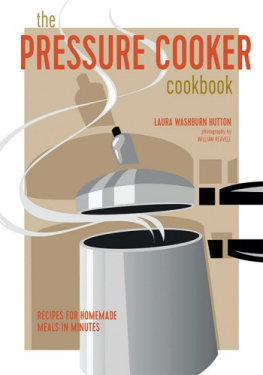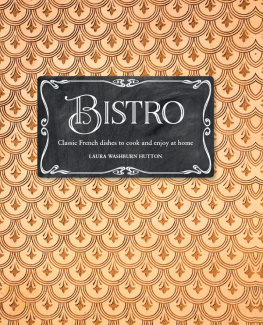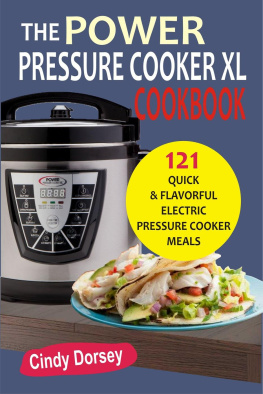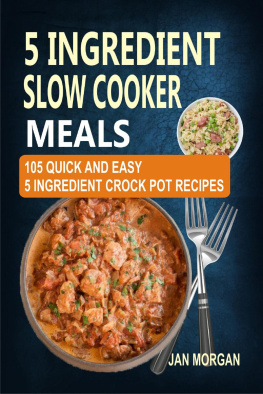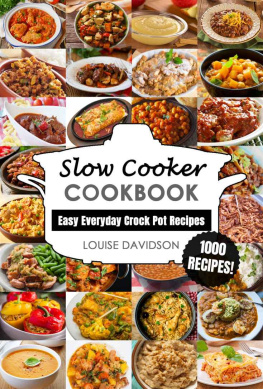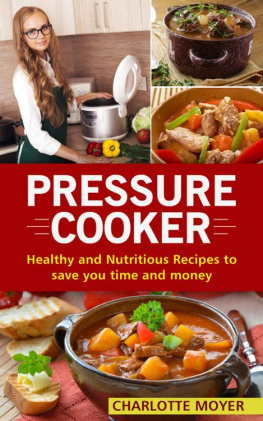the
PRESSURE COOKER
cookbook
the
PRESSURE COOKER
cookbook
RECIPES FOR HOMEMADE MEALS IN MINUTES
LAURA WASHBURN HUTTON
photography by WILLIAM REAVELL

Senior designer Sonya Nathoo
Editor Ellen Parnavelas
Production manager Gordana Simakovic
Creative director Leslie Harrington
Editorial director Julia Charles
Food stylist and recipe contributor
Maxine Clark
Prop stylist Sue Rowlands
Assistant food stylist Sarah Ackhurst
Indexer Claire Hodgson
Authors Acknowledgements
Special thanks to Rosalind Rathouse of Cookery School at Little Portland Street for getting me hooked on pressure cookers, and also to Richard Ehrlich and his daughter Rebecca for the loan of additional cookers.
First published in 2012.
This revised edition published in 2023 by
Ryland Peters & Small
2021 Jockeys Fields
London WC1R 4BW
and
341 East 116th Street
New York, NY 10029
www.rylandpeters.com
10 9 8 7 6 5 4 3 2 1
Text Laura Washburn Hutton 2012,
2023 with the exception of the recipes on
pages 46, 53, 67, 71, 86, 89, 94, 97, 105,
114 text Maxine Clark 2012, 2023
Design and commissioned photography
Ryland Peters & Small 2012, 2023
See page 128 for additional image credits.
ISBN: 978-1-78879-545-6
EISBN: 978-1-78879-546-3
The authors moral rights have been asserted. All rights reserved. No part of this publication may be reproduced, stored in a retrieval system or transmitted in any form or by any means, electronic, mechanical, photocopying or otherwise, without the prior permission of the publisher.
A CIP record for this book is available from the British Library.
US Library of congress cataloging-in-publication data has been applied for.
Printed and bound in China
Notes
Both British (Metric) and American (Imperial oz. plus US cup) measurements are included in these recipes for your convenience. Work with one set of measurements only and do not alternate between the two within a recipe.
All spoon measurements are level unless otherwise specified: 1 tsp = 5 ml, 1 tbsp = 15 ml.
Read your pressure cooker manual before you begin cooking and always use according to the manufacturers instructions. Be aware that pressure cookers may vary slightly from manufacturer to manufacturer, and always check the recipe with your models directions for a recipe which uses the same or similar ingredients.

contents



Mention the words pressure cooker and most people think of large, antiquated aluminium vessels and ceiling-splattering explosions. However, pressure cookers have come a long way since those days.
The first time I saw a pressure cooker, I was living in France as an exchange student. I stayed with several different families and each one approached cooking differently but they all used pressure cookers. I was curious and keen to learn about cooking, but as much as I liked spending time in the kitchen watching my French host family while they cooked, I was afraid of watching them use the pressure cooker. It was an unfamiliar sight and I found the hissing noises and steam quite frightening. I was always very keen to leave the kitchen when the pressure cooker came out.
It has taken me 30 years to overcome my fear and tackle pressure cooking, but I was determined to try and I am very pleased I did. Pressure cookers are remarkable cooking utensils and my one regret is that it has taken me so long to come round to using them.


Pressure cookers have evolved over time and today they are nothing like the steaming, hissing pots I remember from French kitchens past, though many of my fears were unfounded.
My family never had a pressure cooker when I was a child because I grew up in a warm climate and much of our home cooking was done on the outdoor gas barbecue. With this background, I was not an expert, or even a fan of pressure cooking when I started using one.
As a food writer, I am increasingly aware that while many people enjoy cooking, lack of time is often a problem. I thought it seemed important to find a way to lure time-pressured cooking enthusiasts back into the kitchen and the pressure cooker turned out to be the solution I was looking for.
At the cookery school where I work, we began using pressure cookers because they offer a way to speed up time-consuming tasks such as stewing meat and cooking with dried pulses, because it is often difficult to fit everything into a single class.
As I became accustomed to using pressure cookers for my work, I thought of ways to use them in my home kitchen and the idea of writing a collection of recipes specifically for the pressure cooker was born.
Pressure cookers save time, and we can all do with more of that. A pressure cooker is perhaps the most effective time-saving kitchen utensil you will ever own. It also offers a healthy way to prepare foods by retaining more nutrients thanks to shorter cooking times and it saves energy because the foods cook so quickly. There is no longer any excuse for not using one, and if I can manage it, anyone can.
A POTTED HISTORY
Domestic pressure cookers came into being as a time-saving device based on professional models, but they went out of fashion when demand could not keep up with supply and less reliable cookers came into the market. In North America, the decline came in the 1950s when the market was flooded with poorly produced pressure cookers which resulted in many kitchen disasters. Eventually, many home cooks fell out of love with pressure cookers due to their lack of reliability.
Deemed untrustworthy, pressure cookers were relegated to the backs of kitchen cupboards and other time saving devices and culinary equipment became more fashionable. Speed, however, was still of prime importance and frozen convenience foods and microwaves stepped into the place of the forgotten pressure cooker.
The new generation of pressure cookers are very easy to use and have much more effective safety features. While they have gone out of fashion in North American and some European kitchens, they have long been used in many other places, especially India and North Africa, where their fuel-efficiency and time-saving qualities are highly prized. They are also well suited to the traditional cuisines of these areas as pressure cookers work well for simmering stews and soups containing inexpensive cuts of meat or dried pulses.
In spite of the time-saving advantages, pressure cooking is not a good way to cook everything. A pressure cooker cooks some foods very well, and many things badly so it is important to understand which foods work best to make the most of your pressure cooker.
Next page
